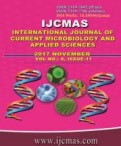


 National Academy of Agricultural Sciences (NAAS)
National Academy of Agricultural Sciences (NAAS)

|
PRINT ISSN : 2319-7692
Online ISSN : 2319-7706 Issues : 12 per year Publisher : Excellent Publishers Email : editorijcmas@gmail.com / submit@ijcmas.com Editor-in-chief: Dr.M.Prakash Index Copernicus ICV 2018: 95.39 NAAS RATING 2020: 5.38 |
The best two each of cellulolytic (C1andC2) and lignolytic (L1 and L2)out of 103 bacterial isolates isolated from compost, sea water, saline soil, black soil and forest soil samples were inoculated on sugarcane trash (S1), paddy straw (S2) and banana pseudostem (S3) and incubated for 20, 40, 60, 80, 100, 120 days to record their impact on physico-chemical properties viz., loss in weight, C: N ratio, cellulose and lignin content of the manures prepared from these substrates. This experiment was conducted using factorial CRD with two repetitions. The highest weight loss was observed in substrate S3 (banana pseudostem), cellulolytic isolate C1 and lignolytic isolate L2 which was corroborated by the lower half-life values of manures i.e. S3 (285 days), C1 (345 days) and L2 (255 days). Treatment effect on C: N ratio was more or less similar to that observed in weight. The cellulose and lignin content was found lower in paddy straw (S2) during all incubation periods as compared to other substrates. Although, a reduction in cellulose and lignin content of substrates was observed in cellulolytic isolates and lignolytic isolates in comparison to untreated control. However, a significant reduction on cellulose content was observed in all inoculated substrates but it absent in case of lignin. Confirmation of best treatment (S3, C1, and L2) and to identify the factors that responsible for rate of degradation of crop residue, regression equation was worked out using almost all possible parameters. Among these, W=12.67+ (0.24 C: N ratio) + (0.12 x % Lignin) – (0.06 x % Cellulose) gave the highest R2 values (0.59). The predicted weight under higher order interactions was calculated by using values of C: N ratio, lignin and cellulose content in substrates. The minimum predicted and actual weight of 16.1 and 15.9g, respectively was recorded under the interaction S3xC1xL2. The study reflects inoculation of agro-waste substrate with cellulolytic isolate C1 (identified as Bacillus licheniformis strain C1) and lignolytic isolate L2 (identified as Bacillus sp. strain L2) have pronounced impact on quality characteristic of manure such as C: N ratio, cellulose and lignin content as well as period required for preparation o manures.
 |
 |
 |
 |
 |